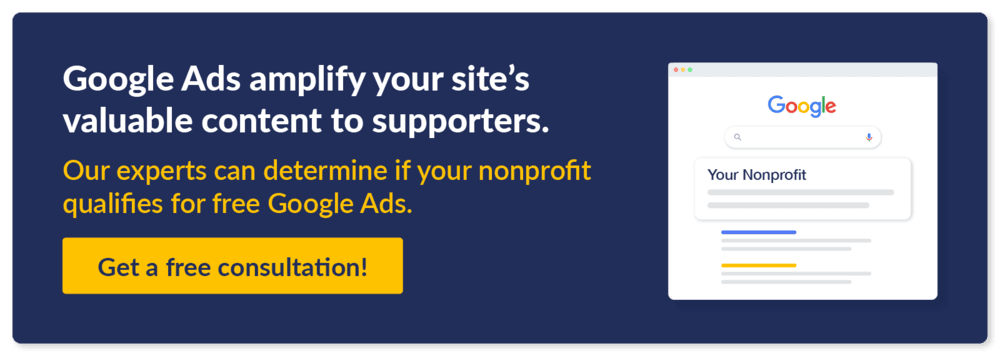Create a Winning Nonprofit Marketing Plan in 8 Key Steps
You’ve worked hard to build an organization that fulfills its mission and makes a difference for the community you serve. However, your work can’t reach its full potential without a strategic nonprofit marketing plan. Outlining a plan is critical for meeting your audience’s needs and driving meaningful conversions.
Whether you’ve never created a dedicated plan before or you want a refresher, we created this guide to walk through the following topics:
- What Is a Nonprofit Marketing Plan?
- Why Is a Strong Nonprofit Marketing Plan Important?
- What Are The Essential Components of a Nonprofit Marketing Plan?
- 8 Steps to Create a Nonprofit Marketing Plan
- Channels to Include in Your Nonprofit Marketing Plan
- Free Nonprofit Marketing Plan Templates to Download
When it comes to representing your mission, reaching your goals, and driving conversions, your team needs a definitive nonprofit marketing guide. Let’s dive into an overview of nonprofit marketing plans.
What Is a Nonprofit Marketing Plan?
A nonprofit marketing plan is a dedicated document that helps marketing teams create promotional materials, stay consistent with branding and goals, and reach target audiences effectively.
This document should be available to everyone in your organization so that no matter the campaign or event you are promoting, your messaging and tactics support your core mission. By maintaining consistency and having a strategic plan you can better communicate with current supporters, acquire new ones, generate sales, and keep all team members on track to reach your goals.
Why Is a Strong Nonprofit Marketing Plan Important?
A strong nonprofit marketing plan should consist of much more than just guidelines for picking the right outreach channels. A well-crafted plan helps nonprofits focus their efforts, allocate resources, and measure results. It’s also essential to document objectives, strategies, and tactics to guide your marketing team and ensure that they’re staying on track.
When you take a comprehensive approach, your nonprofit marketing plan can:
- Provide clarity to your team. No matter what, your team should never lose track of its mission and goals. Your nonprofit marketing plan should outline this information so that your team can communicate it to stakeholders.
- Keep tasks and team members organized. Whether you’re sending out email blasts, creating flyers, launching an SEO strategy, or engaging with donors on social media, marketing campaigns can be overwhelming. A concrete plan eases that stress with guidance on when and how to complete each needed step.
- Focus on reaching your audience. The goals of various marketing campaigns can vary but often include building relationships with your audience, bringing awareness to your mission, increasing sales, and inspiring action from supporters. Your nonprofit marketing plan will walk through your target audience’s motivations as well as the most valuable channels for contacting them.
You won’t be able to accomplish all of this without a well-crafted and developed nonprofit marketing plan. The plan will outline the exact tasks that need to be done, the steps each will take, and when they should be completed.
What Are The Essential Components of a Nonprofit Marketing Plan?
When it comes to your nonprofit marketing plan, be as thorough as possible. Don’t leave any stone unturned to ensure clarity for team members and fill in any gaps in outreach methods.
While your specific marketing plan will be unique to your mission and campaign, several core components will still need to be included.
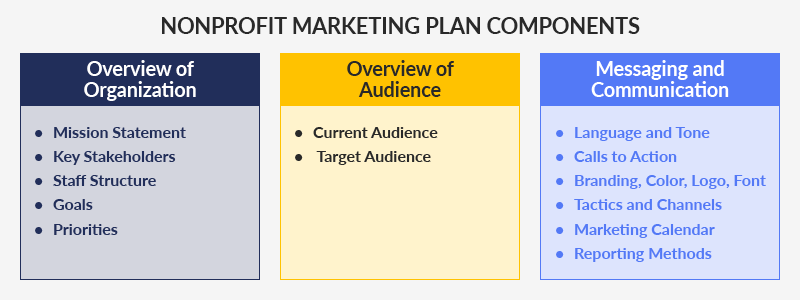
Overview of The Organization
When crafting your plan, start with the basics of your organization. Think about the foundation on which your organization is built. Then, define elements, such as your:
- Mission statement — Your mission statement should summarize why your organization exists, the audience you serve, and how you serve them. Mission statements provide direction for your team members and remind supporters of your nonprofit’s purpose. For example, the ASPCA’s mission statement is “to provide effective means for the prevention of cruelty to animals throughout the United States.”
- Key stakeholders and nonprofit staff structure — Define both internal and external stakeholders, including board members, paid staff, program directors, volunteers, donors, customers, and members. This helps you define your audience, assign responsibilities, and reach out to third parties who may need to be consulted.
- Goals — What exactly is your organization hoping to accomplish? Outlining both long-term and short-term goals can be helpful for your nonprofit marketing plan. This ensures that immediate objectives help support your overarching annual plan.
- Priorities — As you outline your goals, rank them in terms of priority. For instance, if your nonprofit sells products or services, you may need to decide which of your offerings to focus on promoting. You might heavily market new product offerings to bring in new customers or focus on your staples to grow and retain your core base.
Communicating the basics of your organization will give everyone a solid understanding of your mission and what your marketing campaign hopes to accomplish. In turn, your messaging can communicate those aspects accurately.
Audience Overview
Your goal should be to motivate your audience to take action, and that starts with knowing who you want your marketing to reach. As you fill out this section of your nonprofit marketing plan, define the following elements:
- Current audience — What types of people currently support your organization? Look at your nonprofit’s database and determine if there are any commonalities. List out the types of people and entities that consistently donate, buy from, and support your organization.
- Target audience — Who are the people you are trying to reach? For each marketing push, you should have a specific audience in mind. For example, a nonprofit selling professional development courses might serve both individuals and organizations and would need to determine how to market to each group separately.
You create personas for prospective customers using data about your current customers, like their ages, traits, employers, preferred communication methods, and giving preferences. Knowing who currently supports your work and who else you’d like to reach will enable you to connect with the widest audience possible. Even if you already have a strong base of support, you likely want to grow your organization, which is where defining your target audience comes in handy.
Messaging and Communication
Think critically about how you want to present your nonprofit in its messaging. This will set the tone with your audience and establish your brand image. Some key communication elements you’ll want to define in your nonprofit marketing plan include:
- Language and tone — Make sure your language and tone match your mission and audience. For instance, if your organization is focused on education and helping children, you might take on a more friendly and casual tone. Consider including some examples of phrasing or word choices in your plan to make it even easier for your marketing team.
- Calls to action — With your nonprofit’s goals in mind, what are the types of actions you want your target audience to complete? This can range from giving a gift, buying your products and services, signing up for newsletters, or taking another action to show support.
- Branding, color, logo, font — While the aesthetics of your marketing materials might not seem as important as your messaging, it’s crucial that your branding and other design factors are consistent. This ensures that audience members can recognize your organization as soon as they see your marketing content.
- Tactics and marketing channels — How are you going to use your audience and messaging to promote your mission? Your nonprofit marketing plan should outline specific tactics (like donor-segmented email lists) as well as the channels you’ll use.
- Marketing calendar — You’ll likely release content and launch campaigns throughout the year, so it makes sense to include a marketing calendar within your dedicated plan. Schedule email blasts, social media posts, blog publications, and any other marketing materials that will be released.
- Reporting and analytics method — No marketing plan is complete without a valid way to track performance. Make sure you have reporting and analytics set up so that you can follow a campaign’s success and learn about the tactics that made it thrive and the factors that can be improved.
It’s easy to look at these components and think you can fill them out at once. However, it actually takes careful planning and data analysis to accurately determine factors like the most valuable goals to target and which marketing channels to use.
8 Steps to Create a Nonprofit Marketing Plan
With the basic elements of a solid plan in mind, you can move forward with drafting your plan. We’ll break it down into eight easy steps, ensuring you include all of the essentials.
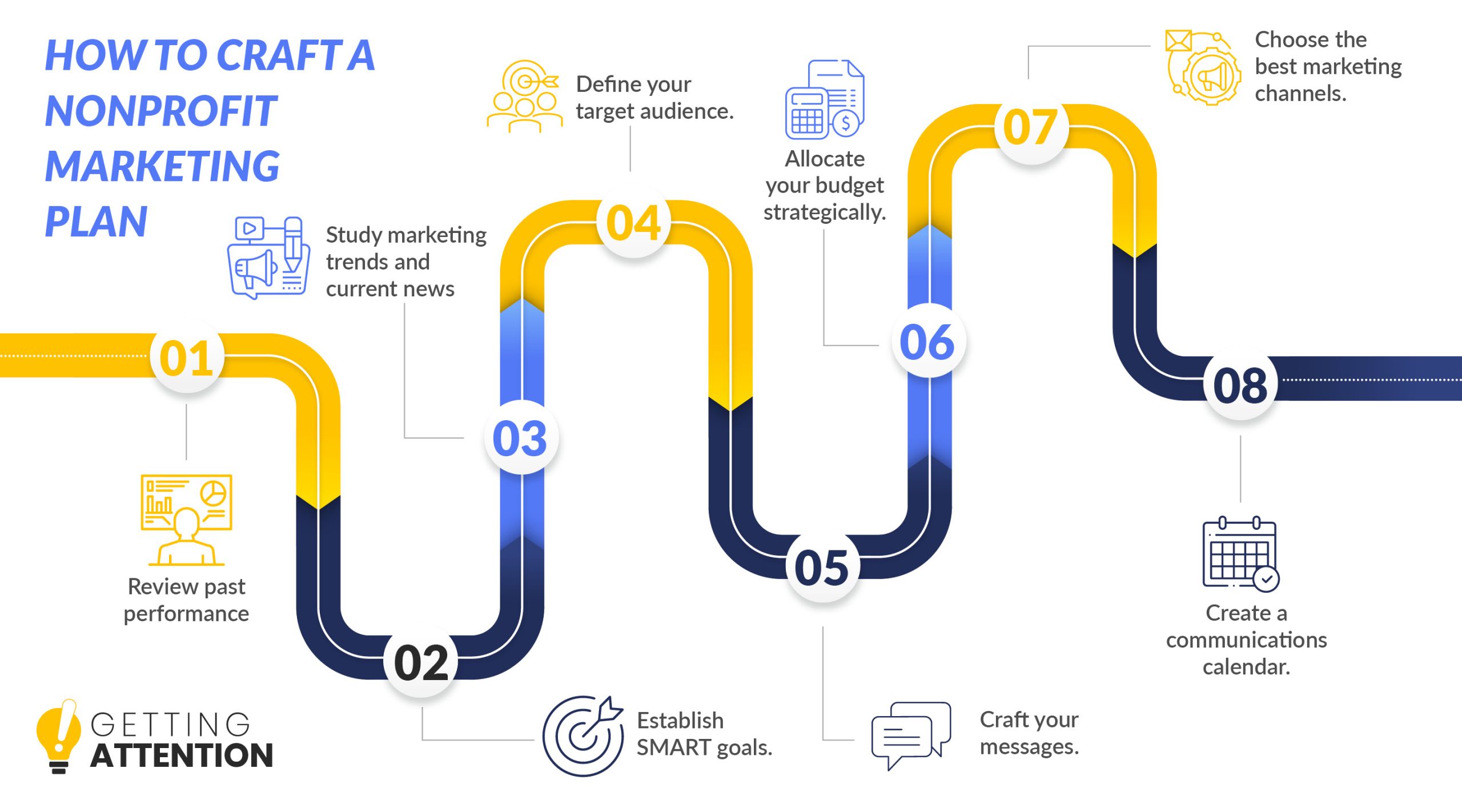
1. Review Past Performance.
Before you really get into the nitty-gritty of your nonprofit marketing plan, take a moment to reflect on your current standing and past performance. To ensure your marketing plan is as valuable as possible, determining what has and hasn’t worked in the past is your best bet.
Review your previous marketing efforts and ask yourself the following:
- Did you achieve your desired goals and objectives?
- What was the most successful part of this strategy or campaign?
- What KPIs did we track? Did they accurately represent the campaign’s success?
- What didn’t go as expected with the campaign?
- What could we do differently in the future, or what strategies should we test to improve performance next time?
- What strategies and outlets should we use again in future campaigns?
- Can any marketing materials (such as photographs, videos, or written content) be repurposed for future campaigns?
Analyzing data, having a sense of your past efforts, and determining the gaps in your strategies will help determine how you can improve your next campaign. If you’re not sure where to start, consider working with a nonprofit marketing consultant.
How to Conduct A Nonprofit Marketing Audit
Along with reviewing past performance, you can even conduct a more in-depth marketing audit. Start by collecting various marketing assets and resources. That way, you’ll have all the information in one place and will be better able to consider your options.
From here, we recommend conducting a SWOT analysis. This method is a strategic planning technique used to help a person or organization identify strengths, weaknesses, opportunities, and threats related to competition or project planning.
Here’s a breakdown of this approach:
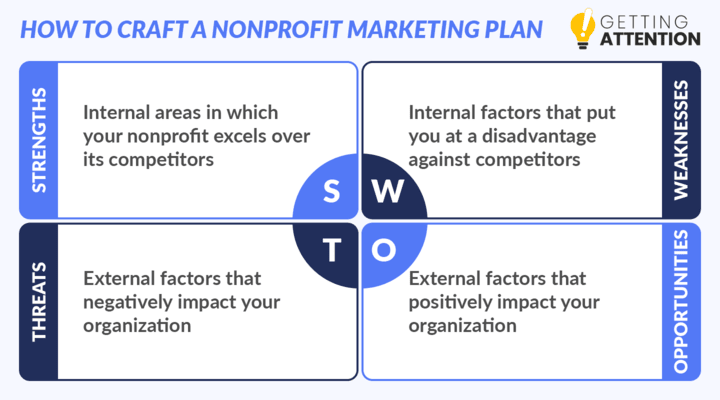
- Strengths: List anything your nonprofit excels at and separates it from other similar organizations. These might include an exceptionally loyal base of donors, a skilled staff, or unique services.
- Weaknesses: This refers to the internal characteristics of the organization that put it at a disadvantage compared to its competitors. This category could include things such as vacant staff positions, a lack of name recognition, or limited resources.
- Opportunities: This refers to external factors that could be beneficial to the organization. These could include things such as grants received, a growing market, or new technology.
- Threats: Name any external factors that could negatively impact your work. For example, these could include a reduction in government funding, an increase in competition, or economic turbulence.
Knowing what’s actively working to help you and what’s working against you will help you craft a holistic nonprofit marketing plan. After completing your analysis, create an action plan based on what you discovered in your audit. What’s working? What could be improved? Where are the gaps? What’s your unique value proposition that other organizations can’t bring to the table?
In many cases, your internal marketing team can successfully conduct a marketing audit. If this is your first time or you don’t have an established team yet, consider working with a professional marketing consultant.
2. Establish SMART Goals for Your Nonprofit Marketing.
Once you have an idea of your past marketing performance, your current resources, and relevant data trends, you can move forward with setting actionable goals.
Your goals should be carefully chosen and aimed to drive meaningful conversions that support your overall mission. That’s why we recommend using the SMART goal-setting method:
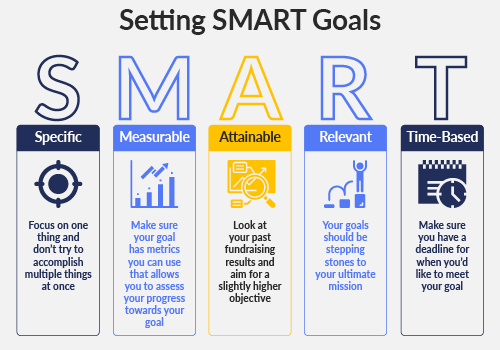
- Specific: Your goal should be as specific as possible — focus on one thing rather than trying to accomplish multiple things at once. If it’s a fundraising goal, set a monetary amount; if it’s a conversion goal, determine the rate at which you want to increase actions.
- Measurable: Goals are only useful when you can measure their success and progress. Make sure your goal has metrics attached that allow you to assess your progress toward your goal. This way, if you notice rates dropping, you can adjust your strategies.
- Attainable: To push your team while ensuring you can achieve your goals, look at your past results, and aim for a slightly higher objective. If your goals are so high they seem impossible to reach, they can be demotivating. For example, if you currently only have 10,000 Instagram followers, it’s much more attainable to set a goal of increasing that number to 20,000 than 1 million followers.
- Relevant: Your goals should be stepping stones to fulfilling your organization’s mission. Make sure that every goal you set is helping you get where you want to go.
- Time-based: Making sure you have a deadline for when you’d like to meet your goal further motivates you to achieve it. Even if you don’t accomplish your goal by the deadline, this information can help you plan future campaigns and strategies.
Following this framework will allow you to set clear objectives that drive action. Otherwise, you may end up with overly generic goals like “raise more donations” or “get more social media followers.”
Examples of SMART Marketing Goals
If you need help brainstorming potential primary goals, here are some core ideas to kickstart your creativity:
- Acquire new donors, volunteers, or members
- Sell your products, programs, or services
- Attract new corporate sponsors and strengthen existing partnerships
- Become a thought leader in your area of expertise
- Raise awareness for your mission
Note that you’ll need to take these primary goals and get more specific to give your team concrete numbers to work toward.
Let’s look at a more specific example. Here’s an example of a SMART goal you might set for your nonprofit to increase awareness of animal welfare:
“By the end of this year, we’ll aim to increase email list sign-ups from 1,000 to 1,300 subscribers. In turn, we’ll raise awareness of shelter overcrowding and animal homelessness. To track our progress, we will record sign-ups and create reports biweekly.”
Or, for a nonprofit looking to earn new customers, a goal might be:
“This year, our organization will expand sales lead from search engine traffic by 20% through a dedicated SEO strategy. Our primary metric will be conversions, but we will also track overall traffic and keyword rankings.”
These goals are time-based, have specific and attainable targets, are relevant to the organization’s missions, and include how their success will be measured.
3. Study Marketing Trends and Current News.
While internal nonprofit data and past performance can take you far when it comes to formulating a nonprofit marketing plan, it’s also a good idea to look at current trends and news items that you can incorporate.
For instance, there’s a wealth of nonprofit fundraising and marketing trends released each year. You might see that social media has become more popular for connecting with donors and then prioritize that in your future marketing. Here are some reliable data sources you might use:
- Double the Donation’s Nonprofit Fundraising Statistics, which are regularly updated
- Giving USA: The Annual Report on Philanthropy, which is an annual study with the latest giving and marketing trends
Along with nonprofit trends, you can shape your content to respond to current news events and other important national occurrences. This is known as “newsjacking” and involves leveraging popular keyword searches from relevant stories and other important occurrences, whether that’s a global pandemic or a national holiday.
Social media is the prime place for newsjacking, as more and more people are getting their news from it. In fact, Pew Research Center found that roughly half of U.S. adults get their news from social media.
However, you can still take advantage of the news and trends through your blog, email marketing, and website, especially with the increased reliance on digital news sources. You can even use paid advertising to promote educational news content.
No matter your approach, newsjacking not only helps you reach a wider audience but also lets your supporters know that you’re current and engaged with what’s happening in the world. So, consider its role when creating your nonprofit marketing plan.
4. Define Your Target Audience.
Knowing who your marketing strategy is trying to reach is one of the most valuable ways to improve your outreach efforts and connect with supporters in meaningful ways.
As we touched on earlier, we recommend outlining your target audience by using segmentation and personas in your nonprofit marketing plan:
- Supporter segments — To better reach your audience, divide your supporters based on common traits. As explained by Kindful’s donor segmentation guide, “Separating donors into groups based on specific criteria helps organizations create different versions of the same content so that every reader receives something that connects with them personally.” Segment supporters according to shared characteristics, like whether they’re new donors, current donors, lapsed donors, volunteers, or customers. You can also use demographic traits like age, geographic location, and career.
- Supporter persona — This is a fictional person made up of the traits of your chosen audience segment. Personas allow you to understand the motivations of your audience better and factor those motivations into your campaign strategy. These are extremely helpful because it’s much easier to formulate messaging when you imagine one person versus a vague general group of people.
Let’s walk through an example of how to use segmentation and personas in a fundraising campaign.
Your nonprofit organization focuses on promoting equal education opportunities around the United States. You decide to segment your audience into first-time, repeat, and lapsed donors. For the lapsed donors segment, you create a donor persona of a recent college graduate who has given while still in school, often volunteers with other causes, prefers email communication, and cares deeply about education rights.
As you craft your messaging, keep your ideal donor persona in mind. Perhaps you’ll consider an email campaign that reminds them of their past involvement and mentions how they can provide the quintessential college experience they just had to others in need. You might even include volunteer opportunities they might be interested in and an impact statement of what a future gift could mean.
Using Segmentation in Your Nonprofit Marketing Plan
To incorporate segmentation and personas into your nonprofit marketing strategy, we recommend that you do the following:
- Segment your audience into donation tiers (small, mid-level, or major) and type (first-time, repeat, and lapsed donors).
- Develop various donor personas under each segment. Your personas should be as specific as possible. You might include a description of their support, how much they’ll usually give or volunteer, their preferred method of communication, personal details like education status or age, and other causes they support.
- Craft messaging for each donor persona based on the traits you listed.
Let’s walk through an example. Your nonprofit organization focuses on promoting equal education opportunities around the United States. You decide to segment your audience based on first-time, repeat, and lapsed donors. Within lapsed donors, you create a donor persona of a recent college graduate who has given while still in school, often volunteers with other causes, prefers email communication, and cares deeply about education rights.
As you craft your messaging, keep your ideal donor persona in mind. Perhaps you’ll consider an email campaign that reminds them of their past involvement and mentions how they can provide the quintessential college experience they just had to others in need. You might even include volunteer opportunities they might be interested in and an impact statement of what a future gift could mean.
5. Craft Your Messages.
While your nonprofit is doing good in this world, it doesn’t mean you’re the only organization attempting to make a meaningful difference. It’s not enough to have a solid mission and goals—you need to craft your messaging in a way that stands out from the rest.
The average office worker receives about 100-120 emails daily. You need your messaging to stand out from the crowd, and with a slightly higher average open rate than other industries, nonprofits are at a slight advantage.
Our guide to increasing nonprofit email open rates shares that Brevo has a 46.49% average open rate for nonprofits and 21.89% open rate for all industries, Mailchimp has a 40.04% open rate for nonprofits and 35.63% open rate for all industries, and GetResponse has a 54.54% open rate for nonprofits and 39.64% open rate for all industries. Many other email platforms share similar results.
To drive results like these, one recommendation is to use the CRAM rule in your nonprofit marketing plan:
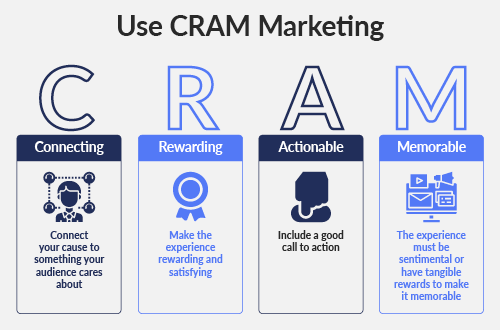
- Connecting — Connect your cause to something your audience cares about.
- Rewarding — Make the experience rewarding and satisfying by letting supporters know what’s in it for them and what kind of difference they’re making.
- Actionable — Your marketing message must have an inspiring call to action.
- Memorable — Supporters’ experience with your organization must be sentimental or have tangible rewards to make it memorable.
One of the best ways to uphold all the qualities in CRAM is to use effective nonprofit storytelling techniques. Use real stories and photos from the communities that you’ve helped and the impact you’ve had on individuals to really drive the point home.
6. Allocate Your Nonprofit Marketing Budget Strategically.
When it comes to your nonprofit marketing plans, there are a lot of moving pieces to manage. Creating materials, maintaining certain channels, and tracking each data point isn’t always cheap.
You need to make every dollar count, so it’s critical that as you lay out your nonprofit marketing plan, you set your budget carefully. Here are a few tips to get started:
- Allocate 5-15% of your operating budget for marketing. Look at your overall budget for the year, take 5-15% of it, and then start dividing it by marketing strategy and channel. It’s better to undershoot your budget than overestimate it when planning.
- Leverage marketing grants to alleviate expenses. Certain channels, such as paid advertising, might initially seem out of reach. However, you can leverage grants like the Google Ad Grant to reduce costs and stretch your budget even further.
- Find free or discounted nonprofit tools. Knowing how to make the most of your limited funds means knowing what tools are within your budget. Free marketing tools exist that can help you promote your mission, but some paid tools even offer discounts for nonprofits.
It’s important to be as specific as possible about the expenses of your campaign as well as the expected revenue and result. This will ensure that you are prepared at every step of the way and that you don’t run into any unexpected budgetary problems. Plus, having your budget already allocated will help get board members and other stakeholders on board.
7. Choose The Best Marketing Channels.
Now comes the exciting part! Remember, before you choose the marketing channels you’ll use, it’s important to determine your target audience and your budget.
There are tons of marketing channels to choose from, and each has its own strengths and challenges. While we’ll explore each one more in-depth later, here are the most popular digital ones:
- Email: This channel is ideal for big project updates and staying connected with current supporters.
- Website: Your website is the hub of your digital marketing efforts. It is the perfect place to explain your mission, post valuable content, and collect information on new prospects.
- SEO: Also known as search engine optimization, SEO is the practice of improving your website to make your content rank more highly on search engine results pages. This helps increase traffic to your website, spread brand awareness, start new donor relationships, and secure sales leads.
- Social media: Known for its sharing features and networking capabilities, social media sites like Instagram and Facebook can help you reach likely supporters.
- Google Ads: Great for promoting your website’s crucial landing pages, Google Ads will help get your content in front of the right prospects. If you meet the Google Ad Grant requirements, you can even leverage this channel for free. You’ll need to create a Google for Nonprofits account, submit your Google Ad Grants application, and create ads once approved!
Along with the strengths of each marketing channel, it’s also beneficial to look at past marketing campaigns and data to see which outlet has had success in the past. If your Facebook fundraisers have shown great promise in both donation amount and shareability, then it’s a good idea to focus more on this channel.
Choosing Multiple Marketing Channels
While pinpointing the best marketing channel for your needs is important, remember that the recommended route of action is to take a multichannel marketing approach. This allows you to use a variety of channels and strategies to work together towards one ultimate goal.
Make sure that your multichannel marketing efforts support each other, especially when leveraging both online and offline communications. For instance, in a direct mail event invitation, you might include a QR code to your online registration page and your social media accounts. Increasing as many touch points as possible will strengthen the bond between donors and your mission, creating a foundation for long-term support.
8. Create A Calendar Within Your Nonprofit Marketing Plan.
You know who you’re targeting, and you have your strategies and messaging all picked out. It’s time to put it all together with a comprehensive and detailed calendar.
This calendar should be a timeline of your marketing plan actions, including:
- The start and end dates of events or campaigns.
- The team and leaders involved, including goals for each member.
- Budget allocations for each event and action.
- Volunteer and staff training dates (if necessary).
- Regular meetings with staff.
- Schedule for releasing content.
Once this is all in place, make sure that your team members are all on the same page. This blueprint will ensure that everyone stays organized. Each individual will know their roles and when to perform actions, streamlining the entire marketing process as it plays out.
Channels to Include In Your Nonprofit Marketing Plan
A multichannel marketing plan is essential for nonprofits to ensure that they use all their resources to reach their target audiences and maximize the impact of their campaigns. A plan that incorporates multiple channels empowers you to connect with your audience in multiple ways.
Whether you’re honing in on digital marketing or print marketing, you can reach different demographics by considering all your options. While print materials can certainly help promote your mission, your plan should lean on the convenience of digital channels to standardize your marketing practices. Let’s take a look at four key digital channels to leverage.

Google Ads
With careful forethought, Google Ads can be an important part of your nonprofit marketing plan. Essentially, the platform enables advertisers to promote key landing pages within Google search results.
For nonprofits, it’s perfect for amplifying donation forms, volunteer opportunities, events, service pages, and educational content. Here’s a Google Ad that promotes a museum’s ticketing page, upcoming events, and a featured exhibit to a local audience:

The Power Google Ads
According to Nonprofit Source’s giving statistics, Google processes an incredible 3.7 billion search queries each day, meaning there are likely plenty of users searching for your cause online. Not to mention, return on ad spend is highest for search ads compared to all other advertising channels.
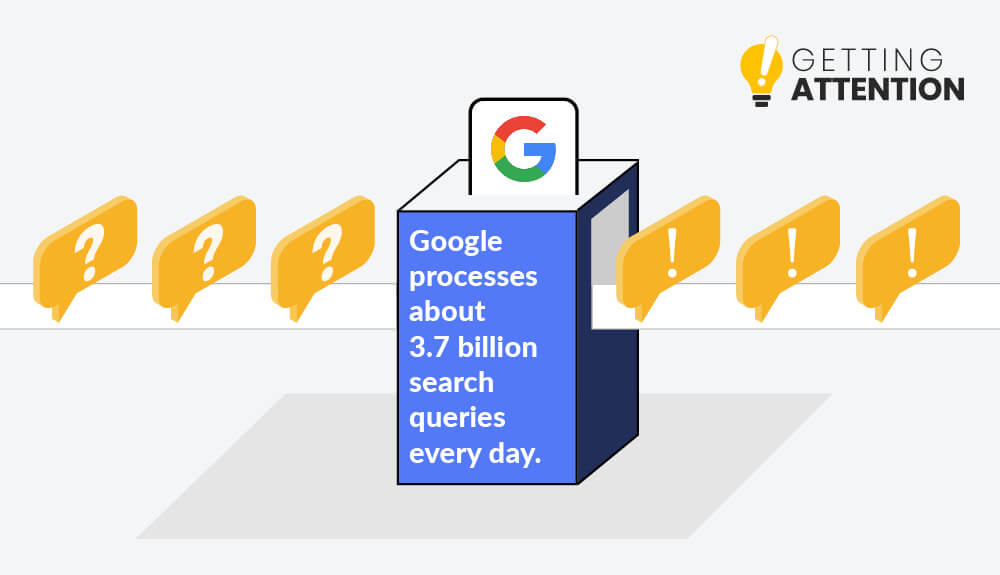
To give you a taste of the power of Google Ads, here are the key benefits you can expect:
- Incredible targeting capabilities: Google Ads allows nonprofits to target specific audiences. When targeting different keywords, demographics, and interests, you can create ads that are tailored to the needs of your different target audiences.
- Ad tracking: Using Google Analytics, you’ll track ad performance and receive important insights that will help optimize campaigns for greater impact.
- Increased brand awareness: Promote your services, reach a wider audience, and spread the word about your mission and activities. In no time, you’ll increase your digital footprint.
If you’re a visual learner, check out this video about the benefits of Google Ad Grants to understand the program’s power:
To get started or seek help creating your ads, partner with a trustworthy Google Grant agency. The experts at Getting Attention are here to help you every step of the way. We’ll walk you through the application process and create compelling ads for your cause!
Search Engine Optimization
Google Ads are a shortcut to the top of search engine results pages, but putting in the work to rank up pages naturally can be well worth it as well. Search engine results that appear on the first page for a keyword, especially the first three positions, often have high click-through rates that can even exceed ad clicks.
You can get your content to start ranking with search engine optimization.
SEO is the practice of improving your website in targeted ways to make it more search engine-friendly. It provides your nonprofit with numerous benefits, including:
- High return on investment. SEO has a minimum ROI of 500% This is because outside of hiring a marketing agency, SEO requires investing time and energy rather than money. While it does require patience, organizations that stick with it can expand their audiences, increase brand recognition, and source quality sales prospects.
- Long-term and continuous results. SEO can take a while to get going with most SEO strategies only seeing results after 3-6 months. However, once your pages start to rank, you just need to maintain them to see continuous traffic from high-value leads. While SEO isn’t a set-it-and-forget-it strategy, it lets your nonprofit position itself so potential customers, donors, and other supporters find you themselves.
- A higher quality website. Most SEO practices generally make your website better. Search engines like Google want to connect their users with quality content, increasing the chances they will continue to use and trust Google. For instance, a few SEO factors are high-value content, functional websites with fast loading times, and mobile responsiveness.
While any nonprofit can try SEO, it’s especially effective at generating revenue for nonprofits with product or service offerings. That’s because fundraising often requires building relationships with supporters over multiple interactions. In contrast, customers ready to make a purchase regularly type in exactly what they want into Google and buy it right then and there.
If your nonprofit sells products or services, we recommend working with an SEO marketing agency. Our favorite is Nexus Marketing.
With more than 10 years of experience in the nonprofit sector, Nexus Marketing has a time-tested strategy for helping its clients create strong, keyword-optimized content that turns interested visitors into valuable sales leads.
Social Media
Any modern nonprofit knows social media is a must for reaching younger donors and supporters. In fact, 59% of Gen Zs are inspired to donate to charity by a message or image they saw on social media.
Here are a few key social media sites you’ll want to bear in mind when crafting your nonprofit marketing plan:
- Facebook: As the largest social media site, Facebook has many amazing features that can help nonprofits market their mission and connect with donors, including Facebook ads that appear on Meta-owned platforms. You can utilize its events features, page creation capabilities, and sharing features. Facebook is also great for showcasing impact, expanding reach, and engaging in conversation among different supporters.
- Instagram: Instagram is an invaluable tool for nonprofits, providing an engaging platform to share visuals of their work and mission. Tap into visual storytelling by publishing images of your volunteers in action and beneficiaries.
- TikTok: TikTok is known for its video creation capabilities. It’s the perfect place to join in on content trends or show off your nonprofit’s work in videos that will capture your audience’s attention.
Leverage these channels to help drive traffic to your nonprofit’s website, start a conversation about your cause, and generally increase visibility for your cause.
Website
Whether you’re trying to drive donations or sales, almost all of your marketing efforts will direct supporters to your website. From first discovering your cause to donating to making a purchase, your website is the first place people go to learn about your organization and the final place they go to show their support.
You can drive traffic directly to your website by posting valuable content to your nonprofit’s blog. You can post anything on your blog, such as:
- Research studies and reports your nonprofit conducted about your target issue
- Updates on projects and initiatives
- Educational content related to your cause and offerings
- Promotions for your products and services
- Stories from supporters, volunteers, and beneficiaries
If your nonprofit is pursuing an SEO strategy, you need a blog. Your blog will host your keyword-optimized content, generating new sales leads. You can also boost your site’s visibility by investing in Google Ads. Remember, approved nonprofits receive free advertising credits by applying for Google Ad Grants.
Email is often the go-to channel for nonprofit marketers because it allows you to connect with all types of supporters. Depending on your nonprofit marketing plan’s goals, it’s ideal for:
- Sending event invitations
- Thanking donors for their gifts
- Providing general updates with a regular newsletter
- Promoting new product and service offerings
- Sharing volunteer, donation, and engagement opportunities
Whether you’re looking to engage new subscribers or retain existing ones, engaging email content is a must in the digital space. With authentic outreach, email can be an intimate platform for cultivating relationships and ultimately speaking with those who trust you on a personal level.
Free Nonprofit Marketing Plan Templates to Download
Planning your nonprofit marketing can be a painstaking process since it involves many moving parts. Feel free to download one (or all!) of these nonprofit marketing plan templates to streamline your planning.
General Nonprofit Marketing Plan Template
This is a holistic template that covers everything you should include in your nonprofit marketing plan. From basic organizational information to your communications schedule, this is a great resource for getting started!
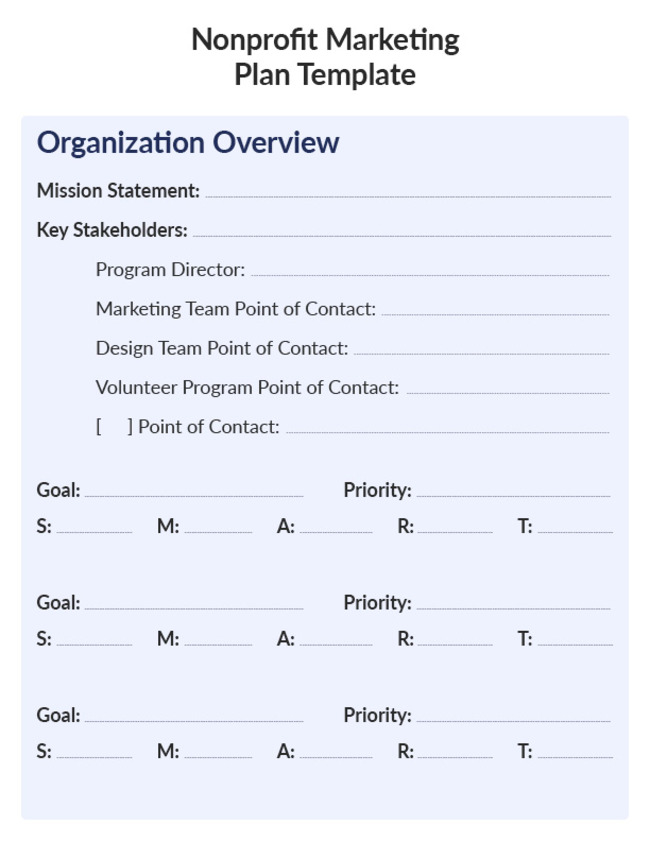
SMART Goals Template
Need a bit of guidance for creating your marketing goals? Try out this template, which breaks down the SMART method.
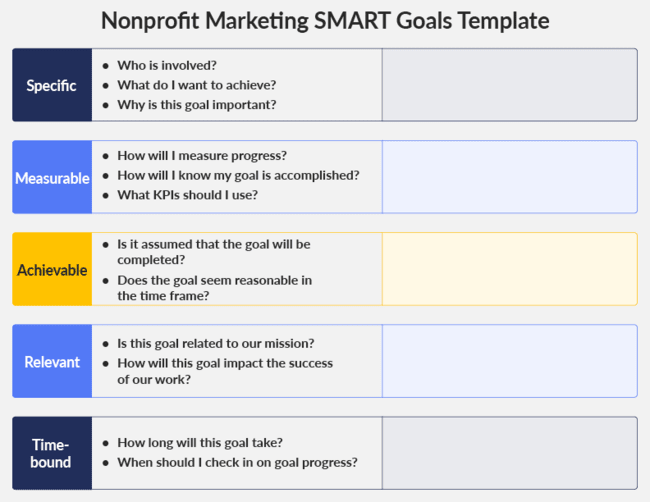
Donor Persona Template
Knowing who your supporters are can help you craft messages that inspire them. Use this donor persona template to explain who you’re targeting with your outreach.
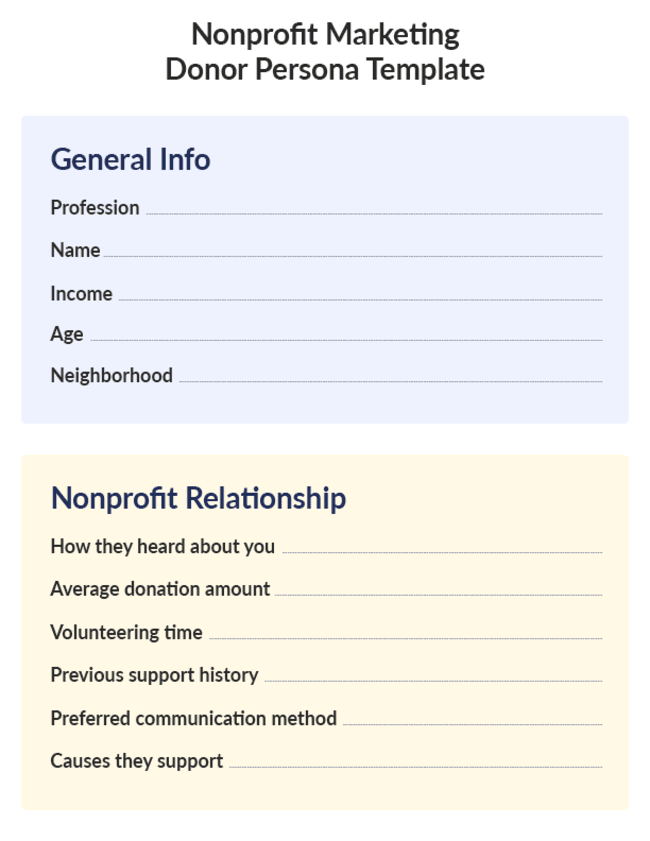
Nonprofit Marketing Plan Budget Template
Budgeting is tricky business! This nonprofit marketing plan template will help you split your budget across different marketing activities.
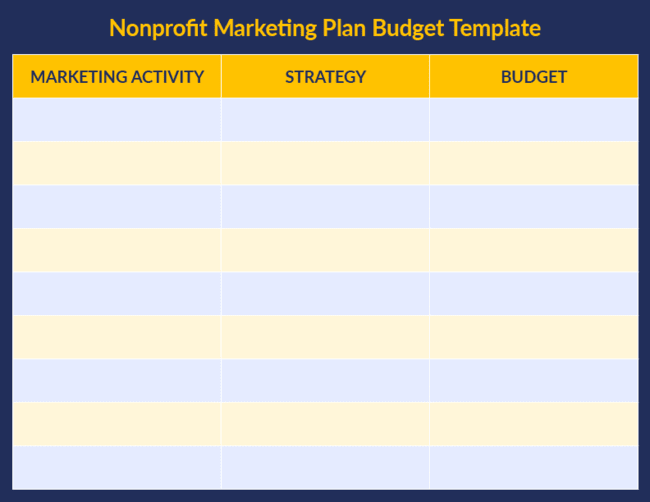
Nonprofit Marketing Calendar Template
As a professional marketer, you’ve got a lot on your plate. Use this template to craft a schedule that will guide your outreach.
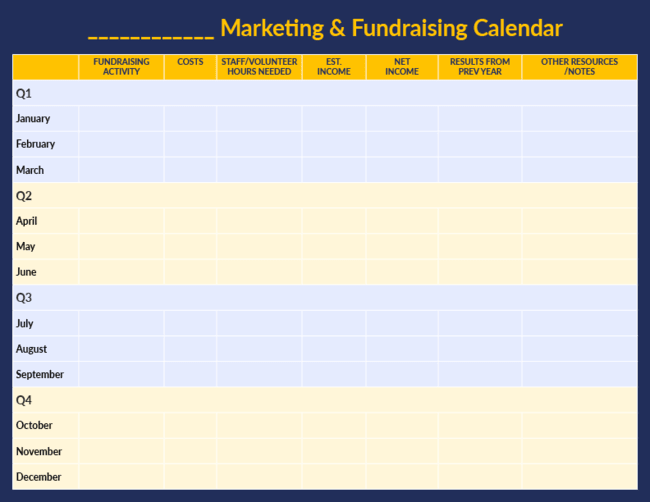
Wrapping Up
A solid nonprofit marketing plan is a must for reaching your nonprofit’s objectives. From setting realistic goals to developing strategies for reaching those goals, a plan will guide you every step of the way. Follow the steps we shared in this guide, and you’ll be well on your way to strengthening your communications.
In the meantime, you still have much to learn! Check out these additional resources that’ll turn you into the ultimate nonprofit marketer of your dreams:
- Digital Marketing for Nonprofits: The Ultimate Guide. Online marketing is a crucial component of your digital identity. Explore the must-know information in this guide.
- Nonprofit Marketing Ideas You Need to Promote Your Cause. Need some ideas to spice up your nonprofit marketing plan? Check out these creative ideas from our team.
- Google Ad Grants for Nonprofits: Promote Your Cause For Free. Google Ads are our absolute favorite way to promote your mission. Learn about the critical role the Ad Grants program can plan in your nonprofit marketing plan.



